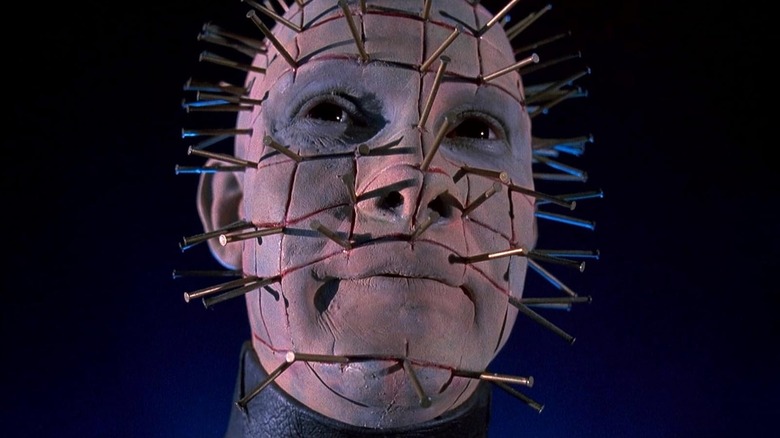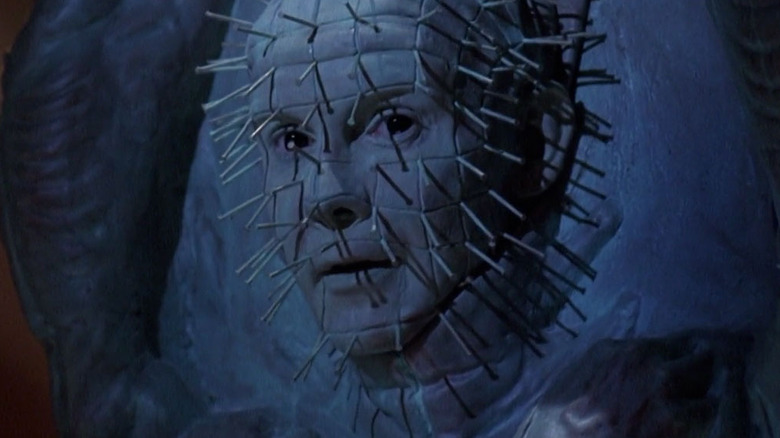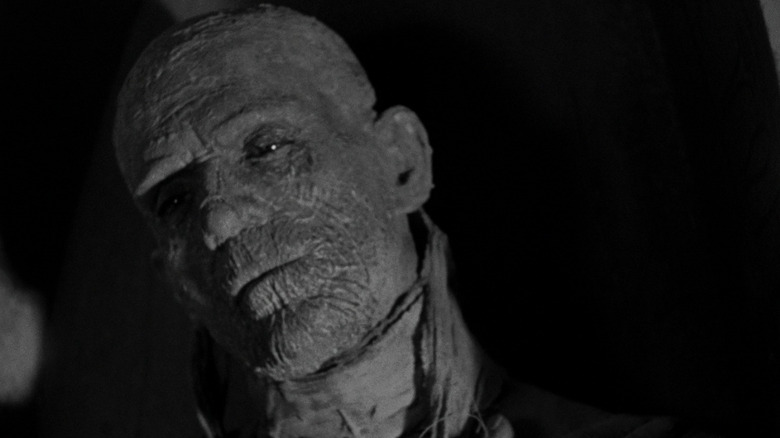Clive Barker's Original Hellraiser III Pitch Was Inspired By A Very Different Horror Classic
At this point, the "Hellraiser" movie franchise is more painful than pleasurable. After all, most of the sequels that've been made since "Hellraiser IV: Bloodline" weren't even originally envisioned as "Hellraiser" films. Determined to retain the rights to the property without spending the big bucks, studios execs at Dimension Films had the mythology forced into random horror movie scripts so they could churn out cheap DTV sequels at their convenience. As you can imagine, these films had such meh sights to show us — a far cry from the disturbing, thought-provoking masterpiece that is Clive Barker's 1987 original.
That said, some fans argue that the "Hellraiser" franchise went off the rails with 1992's "Hellraiser III: Hell on Earth," which sees Pinhead (Doug Bradley) and the Cenobites causing chaos in New York City. The movie is often criticized for bringing run-of-the-mill slasher elements to the property, but it could have been different if Barker's original idea had come to fruition. You see, Barker came up with an origin story for the Cenobites that was inspired by ancient Egyptian mythology and "The Mummy" — a project that also has some significance to the author-turned-filmmaker's career. With that in mind, let's excavate the tomb of "Hellraiser III" and find out what it could have been if its creatives had stuck with Barker's initial plan.
Clive Barker's original plan for Hellraiser III had new sights to show us
The "Hellraiser" timeline explains the origin of some of the Cenobites. In fact, "Hellbound: Hellraiser II" and "Hellraiser III: Hell on Earth" go into some depth about Pinhead, revealing that he was once known as Captain Elliot Spencer, a British soldier who stumbled upon the Lament Configuration in World War I and transformed into the well-spoken demon everyone knows and loves shortly after.
However, Barker's original plan for "Hellraiser III" would have gone into detail about the very first Cenobite, with the idea being that the creature was an ancient Egyptian Pharaoh with an interest in esoteric mysteries. In this unrealized story, the Pharaoh's mummified remains are brought to an American museum along with his treasures and artifacts — which, when aligned in a certain way, open the doors to the Cenobites' world.
This idea was clearly inspired by Universal's original "The Mummy" movie from 1932, which chronicles an expedition that unwittingly resurrects an ancient Egyptian prince. What's interesting, though, is that this version of "Hellraiser III" doesn't feature the long-trusted Lament Configuration to summon the Cenobites, instead preferring a ritual involving the aforementioned treasures. It's a neat idea that is probably more interesting than anything in the movie we got instead. Then again, "Hellraiser III" also introduced the silly CD Cenobite to the lore, so that's a win, and the film is way more entertaining than its naysayers would have you believe.
Unfortunately, it was Barker who shut down the idea for the mummified "Hellraiser III," despite being the person who came up with it. "Hellraiser III" writer Peter Atkins has speculated that the ancient Egyptian element was too similar to another unrealized project Barker worked on in the early 1990s: a remake of "The Mummy" that Universal Pictures wasn't ready for.
Clive Barker's Mummy remake didn't get made, either
The "Hellraiser" franchise was pretty mainstream in the 1980s and '90s ... in the sense that the movies played in theaters and pocketed some change. This also led to Clive Barker being attached to some notable projects related to popular IPs. Rumor has it that he pitched to helm the American "Godzilla" remake after Sony Pictures acquired the rights in 1992, but his idea was shot down for being too dark and twisted. (That project then morphed into Roland Emmerich's 1998 "Godzilla" misfire, for whatever that's worth.)
Despite his success, though, Barker's ideas were too outside-the-box for Hollywood back then. In 1989, his and Mick Garris' pitch for "The Mummy" was similarly rejected for being too dark and sexual — you know, like the first "Hellraiser" movie, which was a success. What's more, the titular Mummy would have been trans, according to Barker in a conversation with Garris on the latter's "Post Mortem" podcast. In this own words:
"The little boy ... who is born at the beginning of the narrative ... has become this exquisite woman. And a major part of a modern-day narrative about 'The Mummy.' But this is our naivety, Mick. How could we ever have thought, in 1989, when we turned this in, that they would say, 'Ah, great!'"
As previously mentioned, Barker's original idea for "Hellraiser III" drew some inspiration from the Universal classic. However, his forward-thinking gender spin on "The Mummy" takes cues from "Hellraiser," as the Hell Priest, aka the demon who later became known as Pinhead, is described as being androgynous in the original "Hellbound Heart" novella. Under Barker's supervision, both properties could have complemented each other, but it wasn't to be. Instead, Universal ultimately went with the 1999 "Mummy" movie starring Brendan Fraser (which is still a highly enjoyable action-horror film). That said, Barker not getting to make his version makes it more upsetting to think about the "Mummy"-inspired "Hellraiser" that never came to be.


